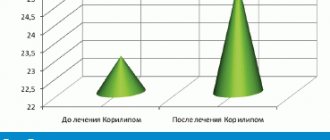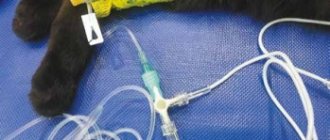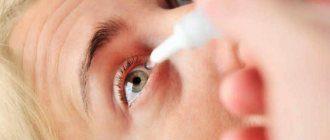Staloral Birch pollen allergen, 3 pcs., 10 TS/ml, sublingual drops (set), Initial course
The effectiveness of ASIT is higher in cases where treatment is started in the early stages of the disease. Dosage and treatment regimen The dosage of the drug and the regimen for its use are the same for all ages, but can be changed depending on the individual reactivity of the patient. The attending physician adjusts the dosage and treatment regimen in accordance with possible symptomatic changes in the patient and individual response to the drug. It is advisable to start treatment no later than 2-3 months before the expected flowering season and continue throughout the entire flowering period. Treatment consists of two stages: initial and maintenance therapy.
1. Initial therapy begins with a daily dose of the drug at a concentration of 10 IR/ml (blue bottle cap) with one click on the dispenser and gradually increases the daily dosage to 10 clicks. One press of the dispenser is about 0.1 ml of the drug. Next, they proceed to daily administration of the drug at a concentration of 300 IR/ml (purple bottle cap), starting with one press and gradually increasing the number of presses to the optimal (well tolerated by the patient). The first stage can last 9 - 21 days. During this period, the maximum dosage is reached, individual for each patient (from 4 to 8 presses daily of the drug with a concentration of 300 IR/ml), after which they proceed to the second stage.
2. Maintenance therapy with a constant dose using a vial of concentration 300 IR/ml. The optimal dose achieved in the first stage of initial therapy continues to be taken in the second stage of maintenance therapy. Recommended dosage regimen: from 4 to 8 presses on the dispenser daily or 8 presses 3 times a week. Duration of treatment Allergen specific immunotherapy is recommended to be carried out in the above two-stage courses (2-3 months before the expected flowering season until the end of the season) for 3-5 years. If, after treatment, improvement does not occur during the first flowering season, the feasibility of ASIT should be reconsidered. Directions for use: Before taking the drug, make sure that:
- the expiration date has not expired;
- a bottle of the required concentration is used.
It is recommended to take the drug in the morning before breakfast. The drug should be dropped directly under the tongue and held for 2 minutes, then swallowed. Children are recommended to use the drug with the help of adults. To ensure the safety and integrity of the drug, the bottles are hermetically sealed with plastic caps and rolled with aluminum caps.
Break in taking the drug If you miss taking the drug for a long time, you should consult your doctor. If you miss taking the drug for less than one week, it is recommended to continue treatment without changes. If the gap in taking the drug was more than one week at the initial stage or during maintenance therapy, it is recommended to carry out treatment again with one click on the dispenser, using the same concentration of the drug (as before the break), and then increase the number of clicks, according to the scheme of the initial stage of therapy to the optimal well-tolerated dose.
Release form
Sublingual drops 10 IR/ml, 300 IR/ml.
10 ml of allergen containing 10 IR / ml and 300 IR / ml in glass bottles with a capacity of 14 ml, closed with rubber stoppers, rolled with an aluminum cap with plastic caps in blue (10 IR / ml) and violet (300 IR / ml).
The set consists of: 1 bottle with allergen 10 TS/ml, 2 bottles with allergen 300 TS/ml and three dispensers or 2 bottles with allergen 300 TS/ml and two dispensers or 5 bottles with allergen 300 TS/ml and five dispensers in a plastic box with instructions for use.
Side effects
Local reactions:
oral: itching in the mouth, swelling, discomfort in the mouth and throat, disruption of the salivary glands (increased salivation or dry mouth)
gastroenterological reactions: abdominal pain, nausea, diarrhea. Usually these symptoms go away quickly, and there is no need to change the dosage or treatment regimen. If symptoms occur frequently, the possibility of continuing therapy should be reconsidered.
General reactions are rare: rhinitis, conjunctivitis, asthma, urticaria require symptomatic treatment with H1 antagonists, beta-2 mimetics or corticosteroids (orally). The physician should reconsider the dosage and treatment regimen or the possibility of continuing ASIT. In extremely rare cases, generalized urticaria, angioedema, laryngeal edema, severe asthma, anaphylactic shock are possible, which requires discontinuation of ASIT.
Rare Side effects not related to Ig-E mediator reactions: asthenia, headache; exacerbation of preclinical atopic eczema;
Slow reactions of the serum sickness type with arthralgia, myalgia, urticaria, nausea, adenopathy, fever, which requires discontinuation of ASIT.
All side effects should be reported to your doctor.
Mode of application
Before using the drug, make sure that:
- the expiration date has not expired;
- a bottle of the required dosage is used.
It is recommended to take the drug on an empty stomach during the day.
The drug should be dripped directly under the tongue using a dispenser and kept in the sublingual area for 2 minutes, then swallowed.
Children are recommended to use the drug with the help of adults.
To ensure the safety and integrity of the drug, the vials are hermetically sealed with plastic caps and rolled with an aluminum cap.
For first use, open the bottle as follows:
1. Tear off the colored plastic cap of the bottle.
2. Pull the metal ring to remove the aluminum cap completely.
3. Remove the rubber plug.
4. Remove the dispenser from the protective packaging. Place the bottle on a flat surface and, holding it firmly with one hand, snap the dispenser onto the bottle and press the top surface of the dispenser with the other hand.
5. Remove the purple protective ring.
6. Press the dispenser firmly 5 times over the sink. After five clicks, the dispenser dispenses the required amount of the drug.
7. Place the dispenser tip in your mouth under your tongue. Press the dispenser firmly as many times as prescribed by your doctor in order to obtain the required amount of the drug. Hold the drug under your tongue for 2 minutes.
8. After use, wipe the dispenser tip and put on the protective ring. It is necessary to place the bottle with the dispenser in the refrigerator immediately after use.
For subsequent use, remove the protective ring and follow steps 7 and 8.
special instructions
If necessary, before starting ASIT, allergy symptoms should be stabilized with appropriate therapy. Patients undergoing ASIT should always carry medications to relieve allergy symptoms, such as corticosteroids, sympathomimetic drugs and antihistamines. You should immediately consult a doctor if you experience severe itching of the palms, arms, soles of the feet, urticaria, swelling of the lips, larynx, accompanied by difficulty swallowing, breathing, or voice changes. In THESE cases, your doctor may recommend taking epinephrine. In patients taking tricyclic antidepressants, monoamine oxidase inhibitors, the risk of side effects of epinephrine increases, including death. This circumstance should be taken into account when prescribing ASIT. In case of inflammatory processes in the oral cavity (mycoses, aphthae, gum damage, tooth extraction/loss or surgery), therapy should be interrupted until the inflammation is completely cured (at least for 7 days). During the ASIT course, vaccination may be carried out after consultation with a doctor. For patients, especially children, on a diet with reduced salt intake, it should be taken into account that the drug contains sodium chloride (one press of the dispenser is about 0.1 ml of the drug containing 5.9 mg of sodium chloride). When traveling, make sure that the bottle is in an upright position. The bottle should be in a box with a protective ring on the dispenser. The bottle should be placed in the refrigerator as soon as possible.
Use during pregnancy and breastfeeding
Pregnancy
ASIT should not be started during pregnancy. If pregnancy occurs during the first stage of treatment, therapy should be discontinued. If pregnancy occurs during the period of maintenance therapy, the doctor should evaluate the possible benefits of ASIT, based on the general condition of the patient. No adverse effects have been reported when using ASIT in pregnant women.
Breast-feeding
It is not recommended to start a course of ASIT during breastfeeding. If a woman continues to perform ASIT during lactation, no unwanted symptoms or reactions are expected in children. There are no clinical data on the use of the drug during lactation.
pharmachologic effect
ASIT is a specific method of therapeutic influence on the immune mechanism during the development of all kinds of allergies. The abbreviation stands for allergen-specific immunotherapy.
The appearance of specific antibodies (IgG4), playing the role of “blocking antibodies”;
decrease in the level of specific IgE in plasma;
decreased reactivity of cells involved in an allergic reaction;
increased activity of interaction between Th2 and Th1, leading to a positive change in the production of cytokines (decreased IL-4 and increased β-interferon), regulating the production of IgE.
Carrying out ASIT also inhibits the development of both the early and late phases of the immediate allergic reaction.
Contraindications
Hypersensitivity to any of the excipients included in the drug;
Active forms of severe immunodeficiencies or autoimmune diseases;
Malignant neoplasms;
Uncontrolled or severe bronchial asthma (forced expiratory volume less than 70%);
Inflammatory diseases of the oral mucosa (erosive-ulcerative form of lichen planus, ulceration of the oral mucosa, mycoses of the oral mucosa);
Beta blocker therapy.
Quantitative determination in the blood of specific antibodies of the immunoglobulin E class to the main (“major”) birch pollen allergen - Betv1 protein PR-10, the identification of which makes it possible to diagnose a true allergy to birch pollen, assess cross-reactivity with allergens of other plants and food products, and predict the effectiveness of allergen-specific immunotherapy.
Synonyms Russian
Specific immunoglobulins of class E to the major birch pollen allergen Betv1 PR-10.
English synonyms
ImmunoCAP t215 (Birch, rBet v1 PR-10), IgE; Silver Birch recombinant (rBet v1 PR-10) IgE Ab in Serum; Silver Birch (rBet v1 PR-10) IgE.
Research method
Solid phase immunofluorescence (ImmunoCAP).
Units
kU/l (kilounit per liter).
What biomaterial can be used for research?
Venous or capillary blood.
General information about the study
An allergen is a substance that causes an allergic reaction. In atopic diseases, allergens stimulate the formation of IgE class antibodies and are causative factors in the development of clinical symptoms of allergic diseases. The detection of specific immunoglobulins E in the blood for a specific allergen confirms its role in the development of type I allergic reaction (reaginic), and therefore allows us to determine the possible “culprit” of the allergy and prescribe appropriate therapeutic and preventive measures.
However, the allergenic substance contains not one, but several protein structures that can act as allergens. Some are “major” - the main allergens, others are “minor” - secondary. Determination of antibodies to recombinant allergens makes it possible to identify the leading component in the composition of complex allergens at the level of molecular allergology. This allows you to differentiate true and cross allergies. The use of recombinant allergens is a new tool in the diagnosis of type I allergic reactions, which allows one to obtain detailed information about the patient’s sensitization, cross-reactivity with other allergens, to justify the feasibility and predict the effectiveness of allergen-specific immunotherapy (ASIT).
Birch pollen is the main and most common trigger of allergic reactions in the spring, which are manifested by allergic rhinitis, conjunctivitis, exacerbations of bronchial asthma and atopic dermatitis, symptoms of oral allergic syndrome.
Allergological testing usually determines sensitization to birch pollen, as a complex allergen that simultaneously includes several allergenic components (Betv 1, Betv 2, Betv 3, Betv 4, Betv 5, Betv 6, Betv 7). Determination of specific IgE antibodies to individual allergenic molecules, recombinant allergens obtained by genetic engineering makes it possible to differentiate true sensitization and cross-reactivity. It is especially important to take this into account when planning ASIT with birch pollen allergens, since it can only be effective in cases of true allergies.
A true allergy to birch pollen is confirmed by the presence in the blood of specific IgE antibodies to the allergic component Betv1 - the PR-10 protein, a ribonuclease pathogenetically associated with the development of sensitization to birch pollen protein. IgE antibodies to the Betv1 allergen are detected in more than 95% of patients sensitized to birch pollen. PR-10 is a heat-labile protein, the allergenic properties of which are reduced after heat treatment, as well as during breakdown in the digestive tract. The structure of PR-10 is homologous to pollen proteins from other trees from the Birch, Beech, Nut families and taxonomically related fruits (apples, apricots, peaches, cherries), vegetables (carrots, celery) and spices. In view of the above, in persons sensitized to the PR-10 protein, in addition to respiratory symptoms to pollen, local manifestations of allergies are often observed when eating fruits, some vegetables, and nuts - oral allergic syndrome in the form of itching, burning, swelling, redness in the oral cavity.
The purpose of this study is to determine specific IgE to the recombinant birch pollen allergen rBetv1 using the ImmunoCAP method. Allergy diagnostics with ImmunoCAP technology is characterized by high accuracy and specificity, which is achieved by detecting low concentrations of IgE antibodies in a very small amount of the patient’s blood. The study is based on the immunofluorescent method, which makes it possible to increase sensitivity several times compared to other diagnostic methods. Worldwide, up to 80% of determinations of specific IgE immunoglobulins are performed by this method. The World Health Organization and the World Allergy Organization recognize diagnosis using ImmunoCAP as the “gold standard”, as this technique has proven its accuracy and consistency of results in independent studies.
What is the research used for?
- Differential diagnosis of true allergy to birch pollen and allergic reactions caused by cross-reactivity with other allergens of plant origin;
- identification of sensitization to the main allergen of birch pollen in patients with allergies to tree and grass pollen and/or polyvalent sensitization;
- identification of possible causes of cross-reactivity between allergens of different plants and products of plant origin;
- resolving the issue of the feasibility of carrying out and predicting the effectiveness of allergen-specific therapy (ASIT) with birch pollen allergens.
When is the study scheduled?
- When examining patients sensitized to pollen of birch and other trees;
- when examining patients with polyvalent sensitization to allergens of plant origin;
- when planning ASIT with birch pollen allergens.
What do the results mean?
Reference values:
| Indicator value kUA/l | Class | Level of allergen-specific IgE antibodies |
| 0 – 0,35 | 0 | Absent |
| 0,351 – 0,69 | 1 | Short |
| 0,70 – 3,49 | 2 | Average |
| 3,5 – 17,49 | 3 | High |
| 17,5 – 49,99 | 4 | Very tall |
| 50,0 – 100,0 | 5 | Intensely high |
| More than 100.0 | 6 | Extremely high |
Reasons for the positive result:
- sensitization to the main allergen of birch pollen.
If sensitization to the Betv1 allergen and the absence of IgE antibodies to the Betv2 and Betv4 allergens are detected, there is a high probability of successful ASIT.
In patients with a true allergy to birch pollen (the presence of IgE antibodies to Betv1) and simultaneous sensitization to minor allergens Betv2 and Betv4, the likelihood of successful ASIT is reduced.
Reasons for negative results:
- lack of sensitization to this allergen;
- long-term restriction or exclusion of contact with the allergen;
- successful implementation of ASIT.
In the absence of sensitization to Betv 1, ASIT with birch pollen allergens will be ineffective.



